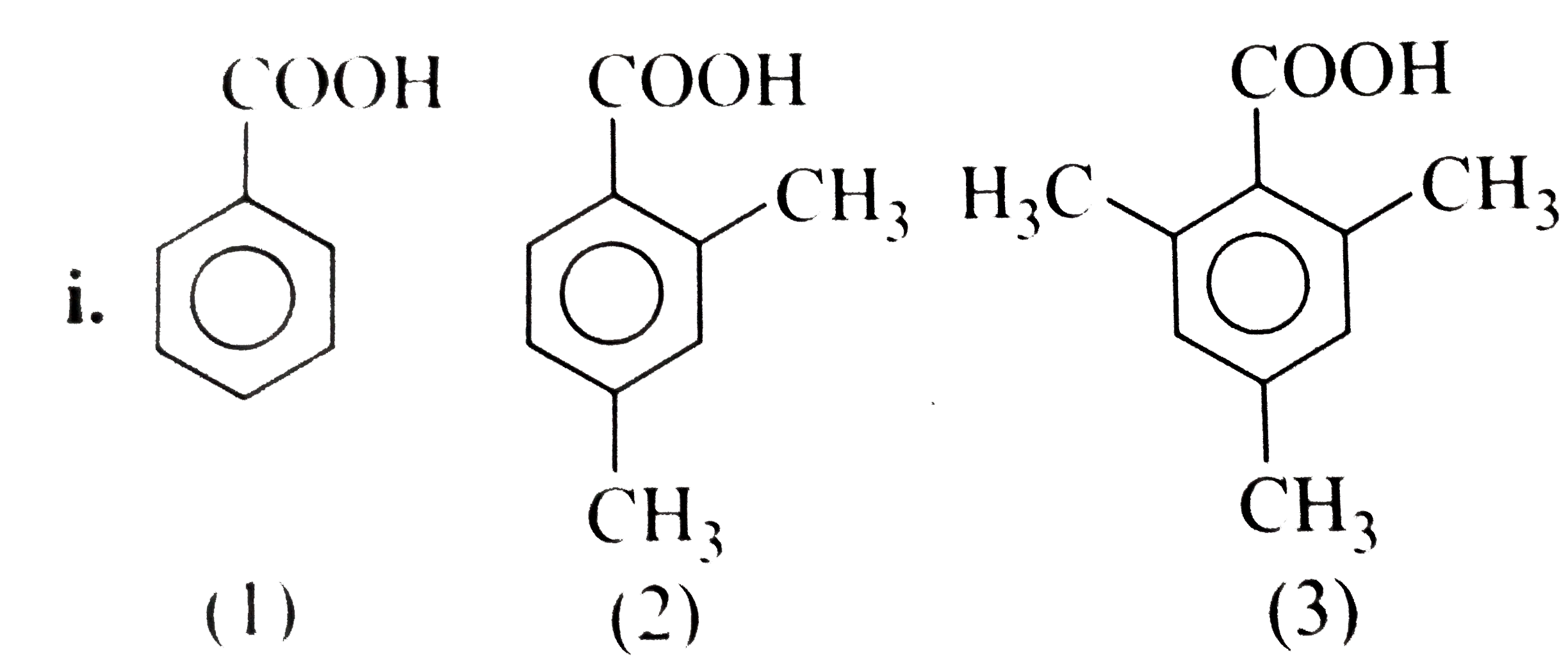CH3COOH does not act as an acid in presence of
A) HCl , B) Na2CO3 , C) H2O , D) C6H6
All are wrong
A and D are correct
A and B are correct
C and D are correct
The correct Answer is:B
HCl is strong acid than CH3COOHandC6H6 is non polar solvent
Topper's Solved these Questions
- BOOK - NARAYNACHAPTER - ACIDS & BASESEXERCISE - C. U. Q (LEWIS THEORY)22videos
ACIDS & BASES
- BOOK - NARAYNACHAPTER - ACIDS & BASESEXERCISE - C. U. Q (IONISATION & IONIC PRODUCT)30videos
ACIDS & BASES
- BOOK - NARAYNACHAPTER - ACIDS & BASESEXERCISE - EVALUATE YOUR SELF-V9videos
ACIDS & BASES
- BOOK - NARAYNACHAPTER - 14TH GROUP ELEMENTSEXERCISE - Subjective Questions6videos
14TH GROUP ELEMENTS
- BOOK - NARAYNACHAPTER - ALKANESEXERCISE - Integer Answer Type7videos
ALKANES
Similar Questions
Knowledge Check
- Question 1 - Select One
The correct order of increasing acid strength of the compounds
(a) CH3COOH
(b) MeO−CH2CO2H
(c) CF3CO2H
(d) Ab<d<a<cBd<a<c<bCd<a<b<cDa<d<c<b
Ab<d<a<cBd<a<c<bCd<a<b<cDa<d<c<b - Question 2 - Select One
C6H5COOH on heating with Na2CO3 releases
ACO2B14CO2CCODnone of these - Question 3 - Select One
Consider the acidity of the carboxylic acids:
(1) PhCOOH (2) o−NO2C6H4COOH
(3) p−NO2C6H4COOH (4) m−NO2C6H4COOH
Which of the following order is correct?A2 > 3 > 4 > 1B2 > 4 > 3 > 1C2 > 4 > 1 > 3D1 > 2 > 3 > 4
What are hybridisation states of each carbon atom
in the following compounds ?
CH2=C=O,CH3CH=CH2,(CH3)2CO,<br>CH2=CHCN,C6H6.View SolutionAmong the following, the number of carboxylic acids which easily undergoes decarboxylation on heating are
HCOOH,(COOH)2,CH2(COOH)2,C6H5COCH2COOH,C6H5COCOOH,C6H5CHOHCOOH
 View Solution
View SolutionWhich out of each pair is expected to be a stornger acid ?
(a) CH3COOH or HCOOH , (b) CH3COOH or C6H5OH
(c) C6H5COOH or HCOOH , (d) CH2(Cl)COOH or CH2(Br)COOH View Solution
View SolutionThe number of weak electrolytes among the following is
CH3COONa,H2CO3,<br>HCOOH,<br>C2H5HN2,<br>Na2CO3,<br>Ca(OH)2,<br>CH3COONH4,<br>HNO2,<br>HIandHF.View Solutiona. Acid halides, anhydrides, esters and amides, all of them contain (C=O) group but none of them gives test for (C=O) group, i.e., they do not form oximes, hydrazones, and DNP derivatives, etc. Why?
b. Arrange the following in the decreasing order of nucleophilic addition.
i. (1)−CHO
(2)−COCH3
(3)−COOH
(4)−COCI
(5)−CONH2
(6)−COOCH3
(7)−COOΘ
ii. (1)CH3CHO
(2)CH3COCH3
(3)HCHO
(4)CH2H5CH2COCH3
iii. (1)CH3COCH3
(2)C6H5COCH3
(3)C6H5COC6H5
(4)C6H5CH2COCH3
iv. (1)C6H5CHO
(2)ρ−CH3.C6H4.CHO
(3)ρ−OH.C6H4.CHO
(4)ρ−NO2.C6H4.CHO
(5)ρ−CI.C6H4.CHO
v. (1)HCHO
(2)CH3CHO
(3)CH3COCH3
(4)CI3CCHO
c. Arrange the following in the increasing order of ease of hydrolysis.
(1)CCH3COOC2H5
(2)CH3COCI
(3)(CH3CO)2O
(4)CH3CONH2
d. Arrange the following in the increasing order of ease of acid-catalysed esterification of:
i.
ii. (1)CH3CH2COOH
(2)(CH3)2CHCOOH
(3)(CH3)3CCOOH
iii. (1)CH3CH2CH2OH
(2)CH3CHOHC2H5
(3)(CH3)2C(OH)C2H5
e. Arrange the following esters in decresing order of ease of alkaline hydrolysis.
i. (1)HCOOCH3
(2)CH3COOCH3
(3)(CH3)3CCOOCH3
(4)(CH3)2CHCOOCH3
ii. (1)CH3COOCH3
(2)CH3COOC(CH3)3
(3)CH3COOCH(CH3)2
(4)CH3COOCH2CH3
iii. (1)C6H5COOCH3
(2)ρ−CH3O−C6H4−CCOOCH3
(3)ρ−NO2−C6H4−COOCH3
(4)ρ−Cl−C6H4−COOCH3View Solution

